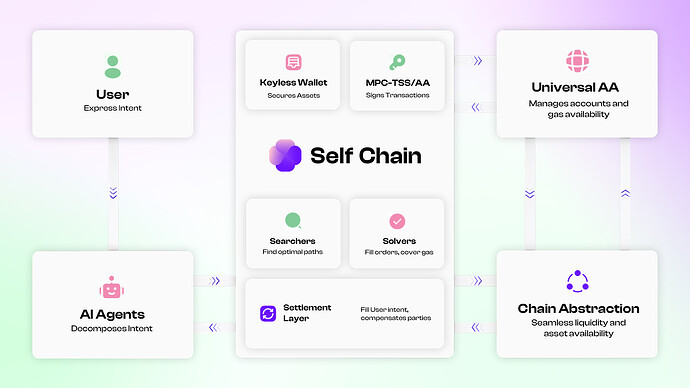Welcome to the second module of Self Academy, your deep dive into the technologies and ideas powering Self Chain.
Today, we dive into Intent Access, a shift that changes how users interact with blockchain technology.
Let’s get into it. ![]()
Web3 today has come a long way but is still exhausting.
Managing private keys, setting gas fees, approving transactions, bridging across chains.
It’s a technical maze that most users aren’t willing to navigate.
The real problem isn’t that users aren’t given enough education on every aspect of web3.
It’s that access is still not extremely simplified.
What is an Intent in Web3?
An intent is not a transaction.
It’s an expression of a desired output.
Instead of manually navigating the space to fulfill a transaction, users simply declare what they want and decentralized systems figure out the best way to execute it.
An example:
Instead of figuring out which chain or DEX to use to carry out a transaction, you simply say:
“Swap 1000 USDT into the best stablecoin farm.”
And the network does the work for you, finding the route, managing gas, and executing securely.
That’s the future Intent Access provides.
Today’s blockchain applications expect users to manually interact at every step, choosing networks, bridges, liquidity pools, gas parameters, and signing transactions.
Intent Access flips the model.
Users no longer micromanage the steps.
They define the outcome, and the network solves the path.
Architecting Intent Access:
The collection of user intent to execution, the process goes through four infrastructure layers:
→ Application Layer: Captures the user’s intent through interfaces like dApps, or AI agents, translating goals into structured messages.
→ Permission Layer: Validates and authorizes the intent, ensuring actions align with user permission and using cryptographic systems like Account Abstraction or MPC-TSS.
→ Solver Layer: Searches across protocols and blockchains to find optimal execution paths, building transaction bundles that satisfy user constraints.
→ Settlement Layer: Finalizes the execution on-chain, ensuring that intents are fulfilled atomically and securely.
Each layer abstracts blockchain complexity away from the user.
Self Chain: Native Infrastructure for Intent Access
Self Chain isn’t adapting to intents, it’s designed around them.
At every layer of its architecture, Self Chain captures, validates, optimizes, and settles intents natively.
→ Keyless wallets powered by MPC-TSS and Account Abstraction authorize actions securely without exposing users to private key management.
→ Solver networks optimize execution across multi-chain liquidity without manual intervention.
→ Settlement happens atomically, ensuring that user goals are fulfilled completely or safely reverted.
The Result?
- No need to learn gas fees, bridges, slippage
- No fragmented UX across different blockchains
- No constant signing and transaction babysitting
- No exposure to private key risks
Users interact with outcomes, not transactions.
Intent Access is a major UX upgrade.
Self Chain delivers the infrastructure needed to move Web3 from manual transactions to autonomous, streamlined goal fulfillment.
The future isn’t just decentralized.
It’s intuitive, autonomous, and driven by intents.
![]() Read more: SELF ACADEMY: INTENT ACCESS
Read more: SELF ACADEMY: INTENT ACCESS


